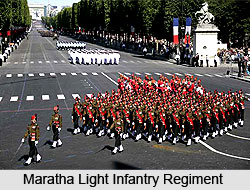 Mardani Khel is an Indian traditional sport nestled in Maharashtra. This traditional sport in India was popular during the early and later medieval era and during the time of Maratha regime.
Mardani Khel is an Indian traditional sport nestled in Maharashtra. This traditional sport in India was popular during the early and later medieval era and during the time of Maratha regime.
Mardani khel is a weapon-based Indian martial art based in Maharashtra. It is particularly known for its use of the uniquely Indian "pata" (sword) and "vita" (corded lance).
History of Mardani Khel
History of Mardani Khel defines the early history from the time of Gupta civilisation. But some historians say that this art existed from the time of 1600 AD. It is said to owe its development to the particular geographic conditions of Maharashtra. A hilly region characterized by valleys and caves, the inhabitants became expert horsemen who favoured light armour and highly mobile cavalry units during war fare. Whether they began as Kshatriya or Shudra is unclear, but the Maratha`s reputation was that of a comparatively rustic warrior people, in contrast to the more “energetic†Panjabis and Rajputs. Their heavily martial culture and propensity for the lance is mentioned as early as the 7th century by the Chinese monk and the explorer Xuanzang.
According to Xuanzang, this band of champions was seemingly not defeat-able in battle. “No enemy can stand before themâ€- This was found in the book of Xuanzang. This allowed their king Pulakeshin II to “treat his neighbours with contemptâ€. Denied his rightful place on the throne by his uncle Mangalesa, Pulakeshi organised an army of warriors and led them against his relative. Feudatories challenged Pulakeshin after his coronation, but his army was able to put down all rivals. After further enlarging his fighting force, Pulakeshin II embarked on a series of conquests, extending the reign of Chalukyas across most of the Dakhin plateau or Deccan Plateau. In 630 AD he confidently defied the emperor Harsha Vardhana who sent all his troops and the ablest commanders but failed to impress Pulakeshin`s army, who were the masters in Mardani Khel.
 Popularity of Mardani Khel
Popularity of Mardani Khel
Mardani khel began its rise to prominence during the early 1600s when the Deccan Sultanates relied on the guerrilla tactics of Maratha units led by Shahaji. His son Shivaji Raje Bhosale learned the art of fighting from a young age and by his adolescence was already proficient in the use of various arms. His weapon of choice was a 4-foot sword named Bhawani. At the age of 17, Shivaji, the Maratha Emperor took advantage of the chaotic affairs of the Deccan region and subverted Bijapuri authority to strike it out on his own. The Maratha community, once scattered across the Deccan, united under Shivaji to create an independent kingdom in the Western Ghats. A Hindu confederacy during a time of intolerant Muslim rule meant that the Marathas were constantly under threat from the Mughals. With limited access to Mughal firearms, they instead capitalized on the local terrain which was unsuitable for the heavy artillery of the invaders. As a result, the Mughals were often forced into hand-to-hand combat, giving the Marathas armies an advantage despite their comparatively light armour.
As with many of India`s fighting systems, Mardani Khel gradually declined in importance during the colonial period when firearms were more widely adopted. Mardani Khel never died out, however, as British Colonial Army of the 18th century recognized the military qualities of the Maratha armies for their art of warfare. Sir G Malet wrote that even after the introduction of guns, few Maratha soldiers of Indian army carried any weapons other than two swords. In the year 1768, the Maratha Light Infantry regiment was formed to protect the British East India Company`s possessions in Bombay (Mumbai).



















